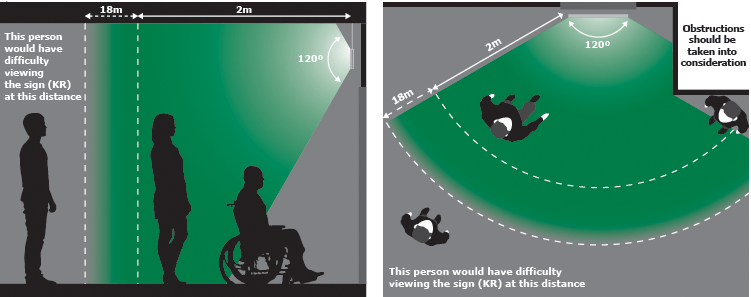
Viewing & Size
Sign Position
Signs should be positioned so that the vertical and horizontal viewing angle is as near to the normal as possible. This will vary dependent on the function of the sign but as an example signs placed 1700mm from deck level will be at the same height as the average viewer’s eye level with minimal vertical viewing angle. Positioning a sign at 2000mm from deck level will maintain a small viewing angle but raise the sign above the average person’s height, making it visible from a crowd. Low Location Way Guidance signs should be placed no more than 300mm from deck level.

Viewing distance
The relative size and shape of the symbol within a sign is designated by International Standards. The viewing distance will vary dependent on the illumination conditions, the angle of viewing and the eyesight of the viewer. International Standards use a formula that compares viewing distance against height of the symbol multiplied by a distance factor when viewed at an incidence angle of 90°. This distance factor varies dependent on the user population and illumination at the surface of the sign. International Standards suggest a general value of 60 can be used for Z? and an example of the formula is given here. For calculation of viewing distance given a specific situation please contact your local supplier.

Sphere of influence of a sign
The location of a sign requires careful consideration in accordance with BS 5499 Part 10. Once in position its influence depends on the size of the sign, the distance and angle of view, the height above the floor, the ambient light, any obstructions and type of material used, i.e. photoluminescent, or ordinary material. There are of course other factors such as height of the viewer, sight impairment, smoke etc. An indication of how these factors affect the sphere of influence of a sign is set out below:-
Sight impaired and smoke
The addition of braille to signs will help and improve considerably the confidence of the visually impaired person. However in smoke conditions (which is often the reason for an urgent exit) everyone is likely to become visually impaired.
Dense smoke tends to rise and therefore the perceived solution is to place signs and way finder guidance systems at lower levels. Some of these systems can be supplemented by a tactile enhancement, comprehensible to those unfamiliar with Braille.



